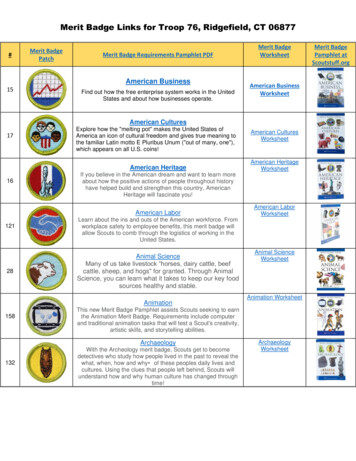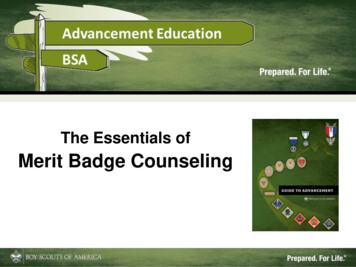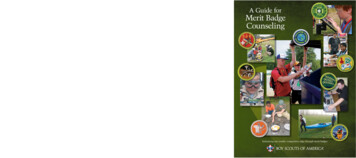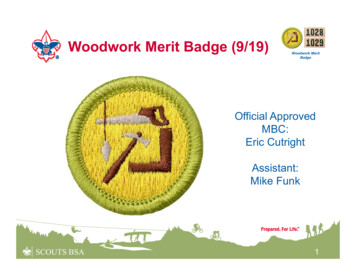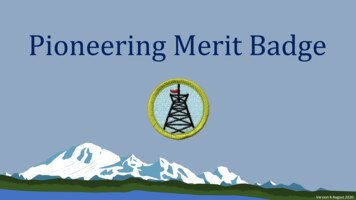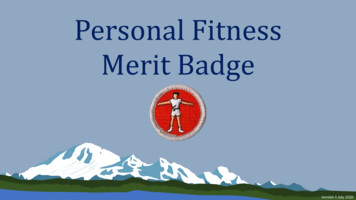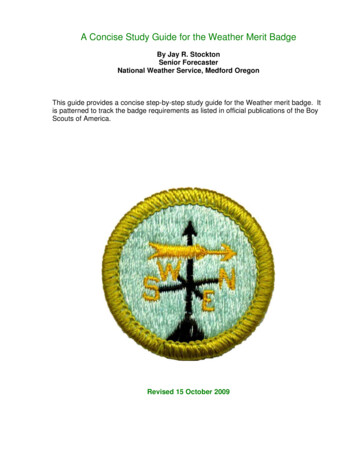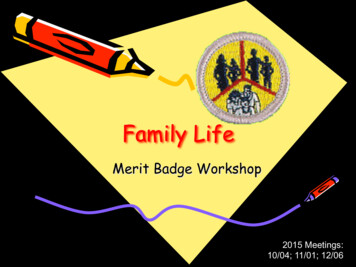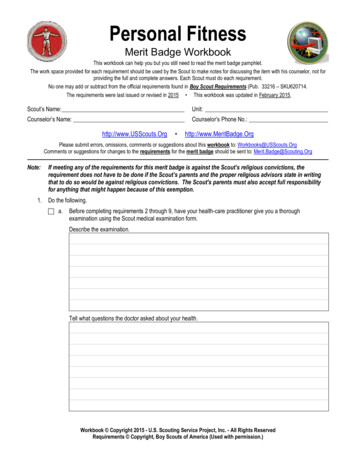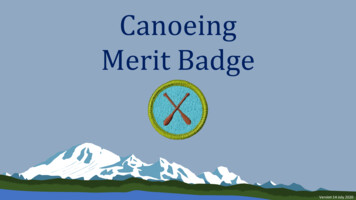
Transcription
CanoeingMerit BadgeVersion 14 July 2020
Index1.2.3.4.5.Merit Badge RequirementsMerit Badge IntroTypes of CanoeingCanoeing BasicsCanoeing Hands On6. Final Thoughts7. Resources8. More Strokes9. Canoeing Videos10.Instructor’s Corner
3Copyright NoticeThis presentation is protected by US and International copyright laws.Reproduction and distribution of this presentation without writtenpermission of the sponsor is prohibited. 2021
4Copyright NoticeDo NOT post or upload copies of thispresentation on the WEB!
5Terms and Conditions of UseThis slide set was designed to aid Merit Badge Counselors to deliver aMerit Badge course and to aid Scouts in completion of a Merit Badge.Scouts, Merit Badge Counselors and other Scouters are free us use thismaterial for teaching and learning Merit Badge requirements. Use ofmaterial in other scout related classes is also acceptable.You may modify (add, delete, change) the slides for your ownpersonalized use.Do not post original or modified versions of these slides on the internet.Questions? Contact the owner.
6DisclaimerThis PowerPoint slideshow was designed to be used to prepare scouts forthe Canoeing Merit Badge and nothing more.Canoeing and water sports are inherently dangerous. This is NOT a how-toguide.This slideshow is NOT intended to be used asa Canoeing reference.Proceed at your own risk and may god have mercy on your soul.
Merit BadgeRequirements
8RequirementsRequirements Merit Badge requirements are dated:January, 2018
9RequirementsRequirements1. Do the following:a. Explain to your counselor the most likely hazards you may encounter while participating in canoeingactivities and what you should do to anticipate, help prevent, mitigate, and respond to these hazards.b. Review prevention, symptoms, and first-aid treatment for the following injuries or illnesses that could occurwhile canoeing: blisters, cold-water shock and hypothermia, dehydration, heat-related illnesses, sunburn,sprains, and strains.c. Discuss the BSA Safety Afloat policy. Tell how it applies to canoeing activities.2. Before doing the following requirements, successfully complete the BSA swimmer test. Jump feet first into waterover your head in depth, swim 75 yards or 75 meters in a strong manner using one or more of the followingstrokes: sidestroke, breaststroke, trudgen, or crawl; then swim 25 yards or 25 meters using an easy restingbackstroke. The 100 yards or 100 meters must be swum continuously and include at least one sharp turn. Aftercompleting the swim, rest by floating.
10RequirementsRequirements3. Do the following:a. Name and point out the major parts of a canoe.b. Describe how the length and shape of a canoe affect its performance.c. Discuss the advantages and disadvantages of the different materials used to make canoes.4. Do the following:a. Name and point out the parts of a paddle. Explain the difference between a straight and bent-shaft paddleand when each is best used.b. Demonstrate how to size correctly a paddle for a paddler in a sitting position and a kneeling position.5. Do the following:a. Discuss with your counselor the characteristics of life jackets most appropriate for canoeing and tell why alife jacket must always be worn while paddling.b. Demonstrate how to select and properly fit the correct size life jacket.
11RequirementsRequirements6. Discuss with your counselor the general care and maintenance of canoes, paddles, and other canoeingequipment.7. Do the following:a. Discuss what personal and group equipment would be appropriate for a canoe camping trip. Describe howpersonal and group equipment can be packed and protected from water.b. Using the containers and packs from requirement 7a, demonstrate how to load and secure the containersand other equipment in the canoe.c. Using appropriate knots, including a trucker's hitch, tautline hitch, and bowline, demonstrate how to securea canoe to a vehicle or a trailer, or if these are not available, a rack on land.
12RequirementsRequirements8. With a companion, use a properly equipped canoe to demonstrate the following:a. Safely carry and launch the canoe from a dock or shore (both, if possible).b. Safely land the canoe on a dock or shore (both, if possible) and return it to its proper storage location.c. Demonstrate kneeling and sitting positions in a canoe and explain the proper use for each position.d. Change places while afloat in the canoe.9. With a companion, use a properly equipped canoe to demonstrate the following:a. In deep water, exit the canoe and get back in without capsizing.b. Safely perform a controlled capsize of the canoe and demonstrate how staying with a capsized canoe willsupport both paddlers.c. Swim, tow, or push a swamped canoe 50 feet to shallow water. In the shallow water, empty the swampedcanoe and reenter it.d. In deep water, rescue a swamped canoe and its paddlers by emptying the swamped canoe and helping thepaddlers safely reenter their boat without capsizing.
13RequirementsRequirements10. With a companion, use a properly equipped canoe to demonstrate the following paddling strokes as both a bowand stern paddler:a. Forward strokeb. Backstrokec. DrawFor stern paddling only:d. J-strokee. Pushawayf. Forward sweepg. Reverse sweeph. Rudder strokei. Stern pry
14RequirementsRequirements11. Using the strokes in requirement 10, and in an order determined by your counselor, use a properly equippedcanoe to demonstrate the following tandem maneuvers while paddling on opposite sides and without changingsides. Each paddler must demonstrate these maneuvers in both the bow and stern and on opposite paddlingsides:a. Pivot or spin the canoe in either direction.b. Move the canoe sideways or abeam in either direction.c. Stop the canoe.d. Move the canoe in a straight line for 50 yards.
15RequirementsRequirements12. Use a properly equipped canoe to demonstrate solo canoe handling:a. Launch from shore or a pier (both, if possible).b. Using a single-blade paddle and paddling only on one side, demonstrate proper form and use of theforward stroke, backstroke, draw stroke, pushaway stroke, forward sweep, reverse sweep, J-stroke, andrudder stroke. Repeat while paddling on the other side.c. Using a single-blade paddle and paddling only on one side, demonstrate proper form and use of acombination of a forward stroke, rudder stroke, and stern pry by canoeing to a target 50 yards away. Repeatwhile paddling on the other side.d. Make a proper landing at a dock or shore (both, if possible). Store canoe properly (with assistance, ifneeded).
16RequirementsRequirements13. Discuss the following types of canoeing:a. Olympic canoe sprintb. Flatwater and river touringc. Outriggerd. Marathone. Freestylef. Whitewaterg. Canoe poling
Merit BadgeIntro
18Merit Badge IntroInstructor Introduction
19Merit Badge IntroNeeded for Course Merit Badge Blue Card filled out and signed by your Scoutmastero or other virtual agreement Merit Badge Pamphlet Scout Uniform A positive Scouting focus and attitude
20Merit Badge IntroVirtual Meetings Use your REAL Name and Troop Number if you want creditThis is how we take attendance MUTE yourself unless speaking to the group Please turn your video on so we can see you No Chat SPAMMING If you need to go pee, go If something isn’t working, please let us know!
21Merit Badge IntroVirtual Meetings We can’t do ALL the requirements virtually Option A – Partial Completion Option B – Completion – need proof Please send completed homeworkAFTER the final class Tell us who we should CC about completion
22Merit Badge IntroCourse Overview We will cover most of the requirements for this Merit Badge in class We need proof that you completed these requirementso Please turn in a completed worksheet if possibleThis makes is easier on the counseloro If you can’t complete a worksheet, pleasecontact your councilor for alternatives
23Merit Badge IntroCourse Overview Some of the requirements obviously can’t be completed in classo Proof of completion can be submitted lateroro Ask for a partial completion Blue Card afteryou turn in your partially completed work
24Merit Badge IntroMerit Badge Requirement Checklist 1-6 and 13 – Fill out worksheet 7-12 – Hands on Requirements Turn in complete worksheetIf you can’t do a worksheet – contact counselor
25Final ThoughtsSafetyHands On requirements MUST be completedwith supervision from a PROPERLY TRAINED ADULT
26RequirementsRequirement 2 – Swim TestBefore doing the following requirements, successfully complete the BSAswimmer test.Jump feet first into water over your head in depth, swim 75 yards or 75meters in a strong manner using one or more of the following strokes:sidestroke, breaststroke, trudgen, or crawl; then swim 25 yards or 25meters using an easy resting backstroke.The 100 yards or 100 meters must be swum continuously and include atleast one sharp turn. After completing the swim, rest by floating.
27Merit Badge IntroClass Objectives Cover the basics of Canoeing Safely learn too Paddle a canoeo Maneuver a canoeo Recover a swamped or capsized canoe Have Fun!
Canoeing Safety
29Canoeing SafetyRequirement 1c - BSA Safety AfloatDiscuss the BSA Safety Afloat policy.Tell how it applies to canoeing activities.
30Canoeing SafetyBSA Safety Afloat1. Qualified Supervision. All canoeing activities must be supervised by a mature and conscientious adultage 21 or older who understands and knowingly accepts responsibility for the wellbeing and safety ofthose in his or her care and who is trained in and committed to the points of Safety Afloat. Thatsupervisor must be skilled in safe canoeing, knowledgeable in accident prevention, and prepared foremergency situations. If the adult with Safety Afloat training lacks the necessary canoe operating andsafety skills, then he or she may serve as the supervisor only if assisted by other adults, camp staffpersonnel, or professional tour guides who have the appropriate skills.Additional leadership is provided in ratios of one trained adult, staff member, or guide per tenparticipants. At least one leader must be trained in first aid, including CPR. It is strongly recommendedthat all units have at least one adult or older youth member currently trained in BSA Paddle Craft Safetyto assist in the planning and conduct of all canoeing activities.
31Canoeing SafetyBSA Safety Afloat2. Personal Health Review. All participants must provide a complete health history, signed by a parentor legal guardian, as evidence of fitness for canoeing activities. Participants should let their leaders knowif they have had any recent illnesses or injuries, or if they have any medical conditions such as diabetes,severe allergies, epilepsy, asthma, or heart conditions so that supervision and protection can beadjusted to anticipate any potential risks.
32Canoeing SafetyBSA Safety Afloat3. Swimming Ability. Operation of any canoe is limited to youth and adults who have completed theannual BSA swimmer classification test: Jump feetfirst into water over the head in depth. Level off andswim 75 yards in a strong manner using one or more of the following strokes: sidestroke, breaststroke,trudgen, or crawl; then swim 25 yards using an easy, resting backstroke. The 100 yards must be swumcontinuously and include at least one sharp turn. After completing the swim, rest by floating.Anyone not classified as a swimmer may ride in a canoe as a buddy with an adult swimmer who is skilledin that craft.
33Canoeing SafetyBSA Safety Afloat4. Personal Flotation Equipment. Properly fitted, U.S. Coast Guard–approved personal flotation devices(PFDs) must be worn by every person in a canoe. Type III PFDs are recommended for generalrecreational use.
34Canoeing SafetyBSA Safety Afloat5. Buddy System. All canoeing participants are paired as buddies who are always aware of each other’ssituation and prepared to sound an alarm and lend assistance immediately when needed.When several canoes are used on a float trip, each canoe on the water should have a buddy boat.Buddies either ride in the same canoe or stay near one another in single-person canoes.
35Canoeing SafetyBSA Safety Afloat6. Skill Proficiency. Everyone in a canoeing activity must have enough knowledge and skill to participatesafely. Passengers should know how their movement affects the canoe’s stability and should have a basicunderstanding of self-rescue. Paddlers must be able to control the canoe, know how changes in theenvironment influence that control, and participate only in activities that are within their capabilities. Participants should be instructed in basic safety procedures prior to launch and allowed to proceedonce they have demonstrated the ability to control the canoe adequately to return to shore. Before embarking on a long float trip, paddlers should have either three hours of canoe training andsupervised practice or should be able to successfully complete a 100-yard course and recover from acapsize. Trips on whitewater above Class II must be done with either a professional guide in each canoe orafter all participants have received American Canoe Association or equivalent training for the class ofwater and type of craft involved.
36Canoeing SafetyBSA Safety Afloat7. Planning. Proper planning is necessary to ensure safe, enjoyable canoeing. All plans should include ascheduled itinerary, notification of appropriate parties, communication arrangements, contingencies incase of inclement weather or equipment failure, and options for emergency response.Preparation. Any canoeing activity requires access to the proper equipment and transportation of gearand participants to the site. Determine what state and local regulations are applicable. Get permissionto use or cross private property. Determine whether personal resources will be used or whetheroutfitters will supply equipment, food, and shuttle services. Lists of group and personal equipment andsupplies must be compiled and checked. Even short trips require selecting a route, checking waterlevels, and determining alternative pull-out locations. Changes in water level, especially on movingwater, may pose significant, variable safety concerns. Obtain current charts and information about thewaterway and consult those who have traveled the route recently.
37Canoeing SafetyBSA Safety Afloat7. Planning.Float Plan. Complete the preparation by writing a detailed float plan, noting put-in and pull-outlocations and waypoints, along with the approximate time the group should arrive at each. Travel timeshould be estimated generously.Notification. File the float plan with parents, the local council office if traveling on running water, andlocal authorities if appropriate. Make sure everyone is promptly notified when the trip is concluded.Weather. Check the weather forecast just before setting out, and keep an alert weather eye. Anticipatechanges and bring all canoes ashore when rough weather threatens. Wait at least 30 minutes beforeresuming activities after the last incidence of thunder or lightning.
38Canoeing SafetyBSA Safety Afloat7. Planning.Contingencies. Planning must identify possible emergencies and other circumstances that could force achange of plans. Develop alternative plans for each situation. Identify local emergency resources such asEMS systems, sheriff departments, or ranger stations. Check your primary communication system, andidentify back-ups, such as the nearest residence to a campsite. Cell phones and radios may losecoverage, run out of power, or suffer water damage.
39Canoeing SafetyBSA Safety Afloat8. Equipment. All canoes must be suitable for the activity and seaworthy, and must float if capsized. Allcanoes and equipment must meet regulatory standards, be properly sized, and be in good repair. Spares,repair materials and emergency gear must be carried as appropriate. PFDs and paddles must be sized tothe participants. Properly designed and fitted helmets must be worn when running rapids rated aboveClass II. Emergency equipment such as throw bags, signal devices, flashlights, heat sources, first aid kits,radios, and maps must be ready for use. Spare equipment, repair materials, extra food and water, anddry clothes should be appropriate for the activity. All gear should be stowed to prevent loss and waterdamage.
40Canoeing SafetyBSA Safety Afloat9. Discipline. Rules are effective only when followed. All participants should know, understand, andrespect the rules and procedures for safe canoeing activities provided by Safety Afloat guidelines.Discuss the applicable rules with everyone near the boarding area just before the activity begins. Peopleare more likely to follow directions when they know the reasons for rules and procedures. Consistent,impartially applied rules supported by skill and good judgment provide stepping stones to a safe,enjoyable outing.
41Canoeing SafetyRequirement 1a – HazardsExplain to your counselor the most likely hazards you may encounter whileparticipating in canoeing activities and what you should do to anticipate,help prevent, mitigate, and respond to these hazards.
42Canoeing SafetyHazards StormsDepending on the area and the time of year, storms can be predictedwith some regularity. However, storms can develop at any time andwith a speed that surprises even the National Weather Service.Once you notice an approaching storm, get off the water as quickly aspossible. Carry the canoes onto shore and use ropes to secure themfrom blowing winds and large waves. If caught in a storm, stay low andget to shore. Be prepared to bail water out of the canoe if the rain isheavy.
43Canoeing SafetyHazards Storms – LightningIf you see lightning, keep a low profile in the canoe until you reachshore.During a lightning storm, get off and stay off the water and away fromopen or exposed shorelines.On shore, stay away from tall geographical features such as trees.Remove your PFD, place it on the ground, and kneel on it.
44Canoeing SafetyHazards Wind and WavesWind and the waves it creates have the potential to give you a thrillingride or to swamp your boat. Learning about wind and waves and thehazards they create is an essential part of canoeing.Wind is created when air moves from a high-pressure area to a lowpressure area. Usually absent in the early morning, wind increases asthe rising sun heats the ground and air throughout the late morningand early afternoon. Winds often reach maximum strength bymidafternoon. By sundown, they usually subside to an occasionalbreeze.
45Canoeing SafetyHazards Wind and WavesDo not attempt to paddle acrossa large lake when strong winds are likely
46Canoeing SafetyHazards Wind and WavesWaves result when wind collides with the water. A keen eye will see theripple effect on the water surface as a gentle wind moves across it. Asthe wind increases, so will the size of the waves until they becomefrothy whitecaps. Waves can become so big that they can easily swampa canoe.
47Canoeing SafetyHazards Wind and WavesAlways anticipate wind as part of any canoeing activity. If you are on acanoe trip, start before the winds increase and land beforemidafternoon to avoid the peak wind periods. Paddle along theshoreline to minimize the effects of wind and waves. Whether paddlingwith or against the wind, it is wise to work your way gradually to thedownwind side of an island or point of land. If strong winds makepaddling difficult, go ashore and take a break until the winds die downenough to making paddling safe and fun again.
48Canoeing SafetyHazards Wind and WavesWhen the wind starts really blowing and waves begin to build, kneel inthe canoe to keep your center of gravity low and reduce the chances ofthe boat capsizing.
49Canoeing SafetyRequirement 1b – First-AidReview prevention, symptoms, and first-aid treatment for the followinginjuries or illnesses that could occur while canoeing: Blisters Cold-water shock Hypothermia Dehydration Heat-related illnesses Sunburn Sprains Strains
50Canoeing SafetyFirst-Aid – Body Temperature102 F The human body operates best around 98.6 F101 FHeat Stroke100 F If body loses heat faster than it can generate it,it will fail to function99 F98 F If body overheats and is unable to cool itself,it will fail to functionaHypothermia97 F96 F95 F94 F2019 First-Aid Merit Badge Pamphlet Page 51-55
51Canoeing SafetyFirst-Aid – Cold-Water Shock102 F When cold water hits skin – blood vessels in skin constrict This results in a sudden increase in blood pressure101 F100 F99 F98 FaCold-Water Shock can result in asudden Heart Attack or Stroke97 F96 F95 F94 F2019 First-Aid Merit Badge Pamphlet Page 51-55
52Canoeing SafetyFirst-Aid – Cold-Water Shock 102 FWhen hitting cold water, many will suddenly gasp for airBreathing can increase 10-foldThis can lead to panicLasts for only a few minutes101 F100 F99 F98 FaPanic and uncontrolled breathingcan lead to drowning97 F96 F95 F94 F2019 First-Aid Merit Badge Pamphlet Page 51-55
53Canoeing SafetyFirst-Aid – Cold-Water Shock - Treatment102 F If you Enter Water Unexpectedly101 F Take a minute to catch your breath Relax and float Keep calm and call for help or swim to safety100 F99 F98 Fa97 F96 F95 F94 F2019 First-Aid Merit Badge Pamphlet Page 51-55
54Canoeing SafetyFirst-Aid – Cold-Water Shock - Treatment102 F If you plan to Enter Water Intentionally101 F Check water temperature Wear wet or dry suit depending on temperatures Wear a Personal Flotation Deviceo Helps you floato Dampens initial shocko Insulates you from cold100 F99 F98 Fa97 F96 F95 F94 F2019 First-Aid Merit Badge Pamphlet Page 51-55
55Cold Weather InjuriesFirst-Aid – Swim Failure102 F Muscles and nerves in arms and legs cool quickly Dexterity, hand grip and speed can drop by 60-80% Onset is between 3-30 minutes101 F100 F99 F98 FaHypothermiaYou have about 10 minutesto get to safety97 F96 F95 F94 F2019 First-Aid Merit Badge Pamphlet Page 51
56Cold Weather InjuriesFirst-Aid – Hypothermia102 F Occurs when body loses heat faster than it can generate it101 F100 F Danger if inadequately dressed for cold environment99 F98 FaHypothermia97 F96 F95 F94 F2019 First-Aid Merit Badge Pamphlet Page 51
57Cold Weather InjuriesFirst-Aid – Hypothermia Danger compounded by:o Raino Windo Hungero Exhaustiono Dehydration Being wet and cold is a dangerous combination Cold water transfers heat 25 faster than cold air102 F101 F100 F99 F98 FaHypothermia97 F96 F95 F94 F2019 First-Aid Merit Badge Pamphlet Page 51
58Cold Weather InjuriesFirst-Aid – Hypothermia – Symptoms NumbnessFatigueIrritabilitySlurred speechUncontrollable shiveringPoor judgement or decision makingCan set in in 30 minutes2019 First-Aid Merit Badge Pamphlet Page 51
59Cold Weather InjuriesFirst-Aid – Hypothermia – Symptoms Eventually leads to UnconsciousnessTakes approximately an Hour2019 First-Aid Merit Badge Pamphlet Page 51
60Cold Weather InjuriesFirst-Aid – Hypothermia – 1-10-1 Rule 1-10-1 Ruleo 1 Minute to Catch your Breatho 10 Minutes to Swim to Safetyo 1 Hour before Unconscious2019 First-Aid Merit Badge Pamphlet Page 51
61Cold Weather InjuriesFirst-Aid – Hypothermia – First-Aid Get the victim’s body warm again!o Move to building or tent Remove wet clothing Dry off Warm dry clothes and/or blanketso Warm, sweet liquids if consciouso Warm water in water bottles, wrapped in towel and place in armpitso Observe NEVER Immerse in Warm/Hot Water – this can be lethal!2019 First-Aid Merit Badge Pamphlet Page 51-52
62Cold Weather InjuriesFirst-Aid – Dehydration The body is made up of 70% waterProper hydration is required for basic body functionsDehydration increases the risk of both cold and heat injuriesCold and heat both increase the risk of Dehydration2019 First-Aid Merit Badge Pamphlet Page 53
63Cold Weather InjuriesFirst-Aid – Dehydration Water is lost via:o Breathingo Sweatingo Digestiono Urination2019 First-Aid Merit Badge Pamphlet Page 53
64Cold Weather InjuriesFirst-Aid – Dehydration – Symptoms Signals of Mild dehydrationo Fatigueo Increased thirsto Dry lipso Dark yellow urine2019 First-Aid Merit Badge Pamphlet Page 53
65Cold Weather InjuriesFirst-Aid – Dehydration – Symptoms Signals of Moderate and Severe dehydrationo Dry mouth with little salivao Muscle crampso Dry skino Loss of appetiteo Weaknesso Decreased sweatingo Dizzinesso Decreased urine productiono Confusiono Less frequent urineo Nauseao Dark brown urineo Fainting2019 First-Aid Merit Badge Pamphlet Page 53
66Cold Weather InjuriesFirst-Aid – Dehydration – First-Aid For Mild Dehydration:o Drink plenty of water or sports drinks Drink 1-2 quart/liters over 2-4 hourso Rest for 24 hours and continue to hydrateo Avoid excessive physical activityo May take 36 hours to replace lost fluids2019 First-Aid Merit Badge Pamphlet Page 53
67Cold Weather InjuriesFirst-Aid – Dehydration – First-Aid Moderate/Severe dehydration requires Emergency Careo Needs to be treated in hospitalo Needs IV fluids2019 First-Aid Merit Badge Pamphlet Page 53
68Cold & Heat Conditions & InjuriesFirst-Aid – Heat Exhaustion Brought on by warm weather Often associated with dehydration orinadequate acclimation to heat Common during outdoor activitiesin hot environments2019 First-Aid Merit Badge Pamphlet Page 53
69Cold & Heat Conditions & InjuriesHeat Exhaustion – Symptoms Symptoms of Heat Exhaustion include:o Severe lack of energyo General weaknesso Headacheo Nauseao Faintnesso Sweatingo Cool, pale, moist skino Rapid pulse2019 First-Aid Merit Badge Pamphlet Page 53
70Cold & Heat Conditions & InjuriesHeat Exhaustion – First-Aid First-Aid includes:o Get victim in Shadeo Encourage to drink fluidso Apply cool, wet towels or cloths to the skino Wet victim’s clothing with cool water and fano Raising legs can help them feel better Victim should feel better in two or three hourso Take it easy the rest of the day2019 First-Aid Merit Badge Pamphlet Page 54
71Cold & Heat Conditions & InjuriesHeat Stroke Body overheats to the point of beinglife-threatening (105 F)102 F101 FHeat Stroke100 F99 F Body loses ability to cool itself98 F May occur with over-exertion in hot weather Also occurs with elderly in hot climatesa97 F96 F95 F94 F2019 First-Aid Merit Badge Pamphlet Page 54
72Cold & Heat Conditions & InjuriesHeat Stroke - Symptoms? Symptoms include:o Hot sweaty (but sometimes dry) skino Confusiono Disorientationo Rapid pulseo Shallow breathingo Vomitingo Seizures2019 First-Aid Merit Badge Pamphlet Page 55
Irritability, Ataxia (balance problems), orConfusion are hallmark signs of Heat Stroke73Heat InjuriesHeat ExhaustionFaint or dizzyExcessive SweatingCool, pale,clammy skinHeat StrokeThrobbing HeadacheNo SweatingRed, hotdry skinNausea or vomitingNausea or vomitingRapid, weak pulseRapid, strong pulseMuscle crampsMay loseconsciousnessor have seizures 104
74Cold & Heat Conditions & InjuriesHeat Stroke – First-Aid ?This is LIFE-THREATENINGCool immediately!Call 911! Do it NOW!Cooling includes:o Immersion or spray of cold watero Ice packs wrapped in cloth in armpits and skino Fanningo AC2019 First-Aid Merit Badge Pamphlet Page 55
75Heat InjuriesHeat Stroke – First-Aid
76Minor Wounds and InjuriesBlisters on the Hand and Foot Often referred to as “Friction Blisters” Blisters may form on hands if doingheavy or repetitive work Foot blisters are a common backpacking injury2019 First-Aid Merit Badge Pamphlet Page 35-36
77Minor Wounds and InjuriesBlisters on the Hand and Foot – Hot Spot Hot Spot – tender area before blister begins to formo Stop immediately!o Treat this before it becomes a blister2019 First-Aid Merit Badge Pamphlet Page 35-36
78Minor Wounds and InjuriesBlisters on the Hand and Foot – Hot Spot Hot Spot First-AidKnow your feetCover ballof footKnow your Hot SpotsMoleskin BEFOREand prevent blistersCover bottomof healNo Wrinkles!Wrap aroundback of heal
79Minor Wounds and InjuriesBlisters on the Hand and Foot Prevention - Hando Wear gloves when working Prevention - Footo Wear shoes or boots that fito Change socks if become wet or sweatyo Treat Hot Spots early2019 First-Aid Merit Badge Pamphlet Page 35-36
80Minor Wounds and InjuriesBlisters on the Hand and Foot First-Aido Moleskin donut around blister This reduces pressure on blistero Special blister products can help SecondSkin Blist-O-Ban2019 First-Aid Merit Badge Pamphlet Page 35-36
81Minor Wounds and InjuriesBlisters on the Hand and Foot - Special Expanding Blistero If you must continue to walk with a blister, it may expand or ruptureo At times, it will be better to preemptively drain ito This needs to be done as cleanly as possibleo There is still a risk of infection as drainage creates an entrancethrough the skin2019 First-Aid Merit Badge Pamphlet Page 35-36
82Minor Wounds and InjuriesBlisters – Drainage Clean, Decompress and DressClean Area Soap and water is fine Betadine is better Wipe with alcoholSterilize Needle Heat until red(and allow to cool) or Use rubbing alcoholPierce BlisterCover Blister Pierce base of blister Ideally first use Paper Tape Make one or more holes then Tincture of Benzoin Avoid Cutting with knife then Moleskin or Flex TapeResources: NOLS Blister Curriculum June 2016blisterprevention.com.au shton.squarespace.com THE-ADVANCED-GUIDE-TO-BLISTER-PREVENTION.pdf
83Minor Wounds and InjuriesBlisters on the Hand and Foot - Special Ruptured Blisterso Blisters should be kept intact if possibleo Ruptured blisters are at high risk of infectionso First-Aid – keep them clean and treat as a cut2019 First-Aid Merit Badge Pamphlet Page 35-36
84Minor Wounds and InjuriesBlisters on the Hand and Foot - Sp
Merit Badge course and to aid Scouts in completion of a Merit Badge. . personal and group equipment can be packed and protected from water. b. Using the containers and packs from requirement 7a, demonstrate how to load and secure the containers . or legal guardian, as evidence of fitness for canoeing activities. Participants should let .
